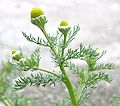- Chamomile
-
Chamomile or camomile (pronounced /ˈkæmɵmiːl/ kam-ə-meel or /ˈkæmɵmaɪl/ kam-ə-myl)[1] is a common name for several daisy-like plants of the family Asteraceae. These plants are best known for their ability to be made into an infusion which is commonly used to help with sleep and is often served with either honey or lemon. Because chamomile can cause uterine contractions which can lead to miscarriage, the U.S. National Institutes for Health says that pregnant and nursing mothers should not consume chamomile. [2] Chrysin, a flavonoid found in chamomile, has been shown to be anxiolytic in rodents,[3][4] and is believed to be at least partially responsible for chamomile's reputation as a sleep aid. Chamomile is the national flower of Russia. It is known to reduce stress.[5]
Contents
Species
There are a number of species whose common name includes the word chamomile. This does not mean they can be used in the same manner as the as the herbal tea known as "chamomile." Plants including the common name "chamomile", are of the family Asteraceae, and include:
- Matricaria recutita (syn. M. chamomilla), German or blue chamomile, commonly used in tea
- Anthemis nobilis (syn. Chamaemelum nobile), Roman chamomile, the "lawn" chamomile
- And to some extent other Anthemis species, such as:
- Anthemis arvensis, corn or scentless chamomile
- Anthemis cotula, stinking chamomile or dog fennel
- Anthemis tinctoria, dyer's chamomile, also called yellow chamomile or golden marguerite
- Ormenis multicaulis, syn. Cladanthus mixtus Moroccan chamomile
- Eriocephalus punctulatus, Cape chamomile
- Matricaria discoidea, wild chamomile or pineapple weed
Etymology
The word derives, via French and Latin, from Greek χαμαίμηλον (chamaimilon) ("earth apple"). The more common British spelling "camomile", corresponding to the immediate French source, is the older in English, while the spelling "chamomile" more accurately corresponds to the ultimate Latin and Greek source.[6]
Medicinal use
Preliminary research suggests chamomile is an effective therapy for anxiety.[7][8]
In Russia, chamomile tea is used for stomach troubles, colds, and muscle aches as well as the usual anxiety and insomnia.[citation needed]
The National Center for Complementary and Alternative Medicine caution of rare allergic reactions (Asteraceae allergy) and/or atopic dermatitis (skin rash).
Gallery
-
German chamomile flowers.jpg
See also
References
- ^ chamomile reference.com
- ^ "Roman chamomile: MedlinePlus". http://www.nlm.nih.gov/medlineplus/druginfo/natural/752.html.
- ^ Brown E, Hurd NS, McCall S, Ceremuga TE (October 2007). "Evaluation of the anxiolytic effects of chrysin, a Passiflora incarnata extract, in the laboratory rat". AANA J 75 (5): 333–7. PMID 17966676.
- ^ Wolfman C, Viola H, Paladini A, Dajas F, Medina JH (January 1994). "Possible anxiolytic effects of chrysin, a central benzodiazepine receptor ligand isolated from Passiflora coerulea". Pharmacol. Biochem. Behav. 47 (1): 1–4. doi:10.1016/0091-3057(94)90103-1. PMID 7906886.
- ^ "Discovery Health "Chamomile: Herbal Remedies"". health.howstuffworks.com. http://health.howstuffworks.com/wellness/natural-medicine/herbal-remedies/chamomile-herbal-remedies.htm. Retrieved 19 August 2010.
- ^ Oxford English Dictionary, online edition, entry "camomile | chamomile"
- ^ "Study Shows Chamomile Capsules Ease Anxiety Symptoms". NIH. http://nccam.nih.gov/news/newsletter/2010_may/chamomileanxiety.htm.
- ^ "A randomized, double-blind, placebo-controlled trial of oral Matricaria recutita (chamomile) extract therapy for generaled anxiety disorder". NIH. http://www.ncbi.nlm.nih.gov/sites/entrez/19593179.
External links
- Chamomile (Matricaria recutita, Chamaemelum nobile) medical and therapeutic information on MedlinePlus
- Chamomile fact sheet, NIH National Center for Complementary and Alternative Medicine
- Roman chamomile, the National Cancer Institute
- PLANTS Profile: Anthemis tinctoria L. (golden chamomile), USDA
 Texts on Wikisource:
Texts on Wikisource:
- Chisholm, Hugh, ed (1911). "Chamomile". Encyclopædia Britannica (11th ed.). Cambridge University Press.
- "Chamomile". Encyclopedia Americana. 1920.

This page is an index of articles on plant species (or higher taxonomic groups) with the same common name (vernacular name). If an internal link led you here, you may wish to edit the linking article so that it links directly to the intended article. Categories:- Plant common names
- Greek loanwords
- Medicinal plants
Wikimedia Foundation. 2010.



